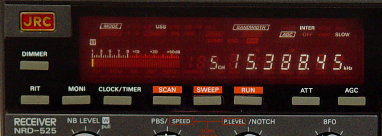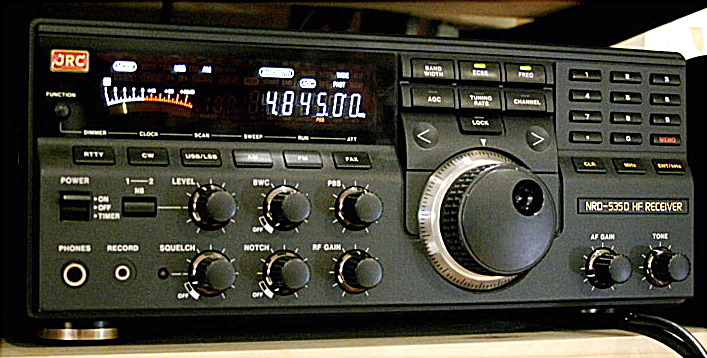|
Japan
Radio Co. JRC
NRD-535 HF Receiver
|
The JRC NRD-535 HF
Receiver.
Hissy IF noise trait that plagued the NRD-525 was cleared up.
However now it was a digital noise problem with the NRD-535 (traded one noise for another).
D version added a poor performing "Sync Detector" along with a mediocre variable
bandwidth feature. RS-232 port was now standard via a DB-25 connector. Dave N9EWO (Paul Lannuier Photo)
Paul Lannuier NRD-535 note (former USA JRC Sales Manager) :
Nice Ass (Button)!
One of the more humorous episodes
to occur during the NRD-535 design review meetings at JRC was the
now-infamous saga of the ASS Button. In 1990 the then-current
marine/GMDSS HF receiver, model NRD-240, had an interesting function
called "Automatic Scan Start", enabled by pressing a front panel button
labeled "ASS". This had already been the source of great amusement at
SWL festivals where I distributed brochures on the NRD-240, not to
mention the endless ribbing I endured by attendees at the Dayton
HamVention where we had the '240 on display.
Now, as the NRD-535 was being
conceived, the ASS button made it's way into the discussions. As the
only person at the meetings whose first language was English, I felt it
was my responsibility to make them understand the marketing
implications of having the word "ASS" appear prominently on the front
panel. This involved a combination of spoken word and insane hand
gestures, with some translation help from Shiono-san. It was bad enough
that they used the prefix "NFG" to denote the JRC line of antenna
tuners. "Please," I begged them, "don't make me market a product with
an ass button!" A moment of silence was quickly followed by an eruption
of laughter as it finally became clear to the group what my fuss was
all about. The ASS button was scrapped, thankfully.
"Caveat Emptor" - JRC Display Failures
Display failures are now very common with the JRC NRD-525, NRD-535 Receivers and even with the JRC JST-135
Transceiver. These radios all use a "custom made" florescent type
display and now being quite aged are suffering from ever weakening
brightness and then just failing completely in time. They have not held
up well with age. One could TRY and replace the 4 high voltage (35 to
50 volt) electrolytic capacitors in the display DC-DC converter
circuit, but usually when these go out.....that's it (it turns into a
great doorstop or computer controlled only set) Sorry...no new parts
are available anymore. So a "MAJOR" Caveat Emptor (buyer beware) if you are considering any used sample for purchase !!
The later NRD-545 Receiver
(plus the JST-145 and JST-245 Transceivers) uses a negative LCD with a
"CCFL" (cold cathode florescent tube) back light. With it's ever
increasing age are also subject to become weak and in time total
failure. Just as with the more elder JRC sets , parts and repair from
JRC are no longer available. So once this tube fails, it becomes a
computer controlled only receiver unless a owner workaround is figured
out (some other way to back light the LCD and or substitute parts) ??
A general reminder, as it goes with all vintage "solid state" radio
receivers / transceivers one should be aware any major ills of any
certain used model before a purchase. Check it out throughly before and
then cross your fingers after. Dave N9EWO

JRC NRD-535 Links (all subject to change without notice)
NRD-535 eham reviews
NRD-535 Owners Manual
NRD-535 Service Manual
HB9RXC RXCommander PC Software JRC NRD-525 / NRD-535
Thomas Nilsson's JRC "NRD 535 and NRD 525 comments and modifications"
Paul Lannuier - "Notes on the JRC NRD-535 Receiver (sorry pictures are missing)"
JRC Amateur and SWL gear (groups.io)
JRC Marine (groups.io)


